The 2019 World Cup won by the Springboks was typified by exemplary defence and set-piece dominance.
By taking a clear cut approach to the game – being hellbent on territorial advancement, they played a game perfectly catered for ‘tournament rugby’.
The intent is to win by the lowest risk means, even if that means sacrificing style for substance.
That means continually kicking with low phase counts, taking threes at every opportunity and putting the ball in the hands of the opposition in disadvantageous positions.
This is an important differentiation to make as next year’s Lions tour will not be ‘tournament’ knockout rugby, and this will likely bring another style of Springbok rugby back into play.
A more expansive style of play with deeper structures more common of the Springboks at home could be expected, with more running with the ball to find the edges with far less kicking than the World Cup.
The Bok pattern
One of the favourite attacking patterns used in search of a try in the red zone by the Springboks under Rassie Erasmus is a ‘wear down’ sequence, using narrow rucks over four or five phases, heading the same direction with each carry.
Understanding the key roles of the backs will help paint the picture of how the Springboks structure their favourite launches.
Scrumhalf Faf de Klerk is the main distributor, with most phases played off 9 to feed forward runners coming around the corner.
The flyhalf, usually Pollard, is a ‘link’ man, a secondary distributor who is typically injected on the ‘release’ phase but does not feature as much as de Klerk and at times, may not be involved at all.
The most vital player in the attacking system is fullback Willie le Roux, who has been the key playmaker in the Springbok backline since Erasmus took over. He was brought back into the national fold by Erasmus likely for this specific reason, as he had demonstrated with Wasps in the Premiership he was one of the world’s best ball-players.
In combination with Danny Cipriani, Elliot Daly, Jimmy Gopperth, and Christian Wade, Wasps had built one of the most devastating attacking systems of recent times with le Roux one of the Premiership’s leaders in try assists.
His ball-playing ability also brings a missing element to the Springboks attack that launch patterns can be constructed around. Le Roux is the man to pull the trigger, so to speak, trusted with making the right decision, manipulating edge defenders and executing the last pass at the right time, as he did with regularity at Wasps.
The multi-phase lead-up work inside is often designed to manufacture the opportunity for le Roux on the edge, who is tasked with creating opportunities for wingers Cheslin Kolbe, Makazole Mapimpi and, previously, Aphiwe Dyantyi.
Early in Erasmus’s reign with the side, against the All Blacks in Wellington in 2018, the Springboks scored their first try through a common ‘Bok pattern’ sequence using le Roux’s finishing instincts.
Below, Malcolm Marx has carried off the back of the lineout maul on the first phase to set the Springboks up around the 22-metre line.
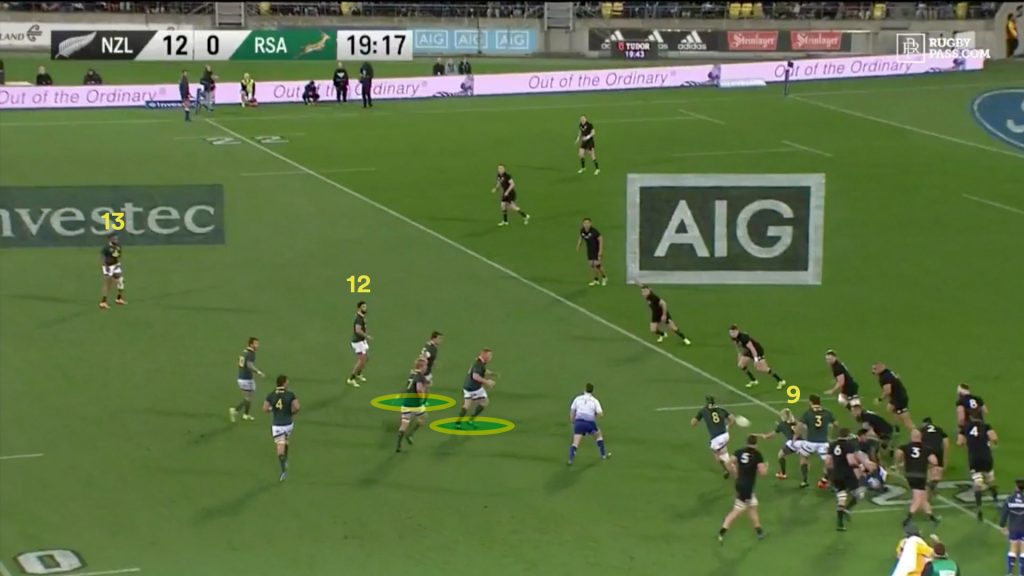
The second phase is a forward carry, followed by a third phase carry by Damian de Allende running a hard line across the front of more forward options.
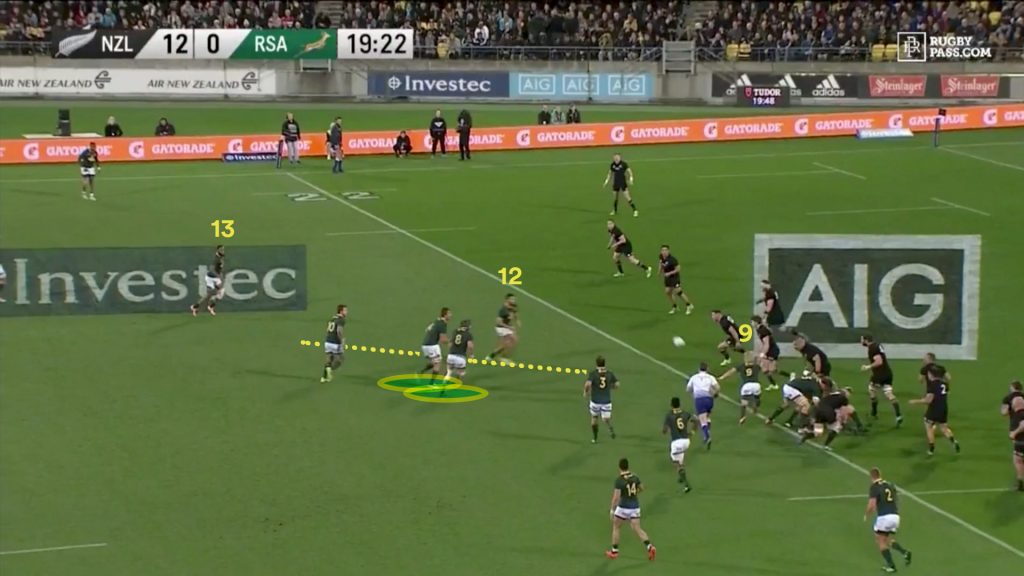
A fourth phase involves Siya Kolisi taking another carry into the All Blacks line. At this point after four consecutive carries, the Springboks have succeeded in whittling down the All Blacks edge, with only the New Zealand outside backs left defending.
Only centre Anton Lienert-Brown and winger Ben Smith remain in the front line, with fullback Jordie Barrett standing deeper.
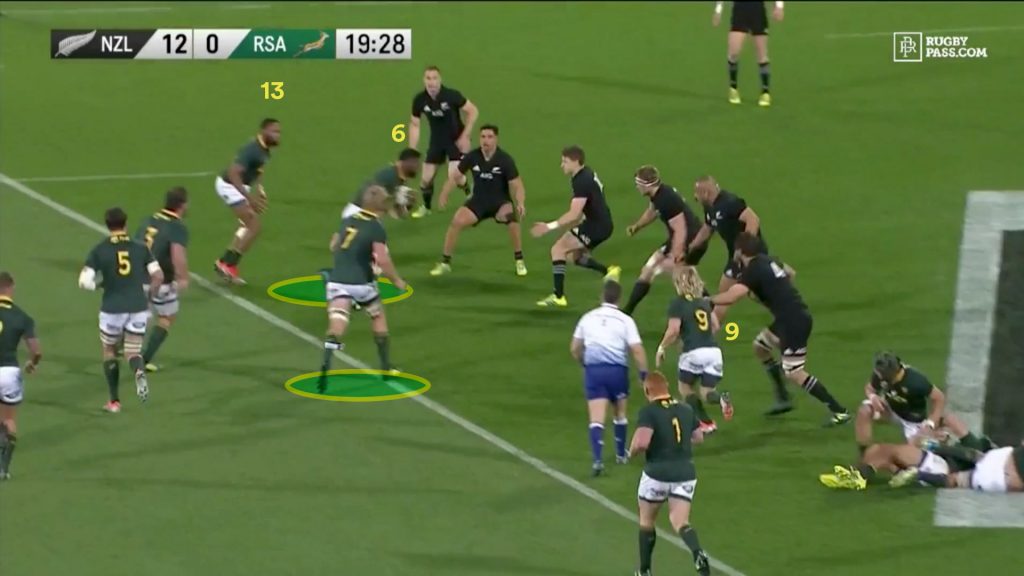
The Springboks are ready for the ‘release’ phase where le Roux will pull the trigger on this short side edge.

All Blacks halfback Aaron Smith signals for extra coverage to cover the short side, but prop Karl Tu’inukuafe and Sam Whitelock aren’t mobile enough to get there due to de Klerk’s recycle speed.
The Springboks use another ‘crossing’ line on the final phase, with lock Franco Mostert (5) running across the face of Anton Lienert-Brown as Faf de Klerk fires the pass deep in search of the edge.
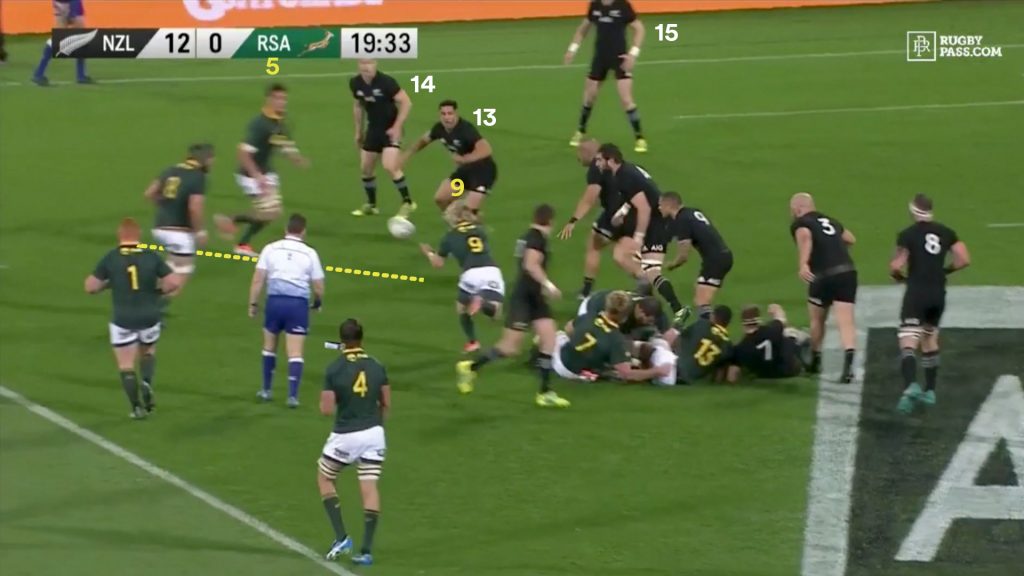
Mostert’s decoy line holds Lienert-Brown’s attention long enough to isolate Ben Smith (14), who then makes an impulse decision to rush Malcolm Marx (2) to prevent the ball getting wider.
Smith’s rush attempt fails to stop the ball getting to le Roux and, more importantly, Smith’s rush isn’t mirrored by the fullback Jordie Barrett who stays back, creating disconnection between the last two defenders.
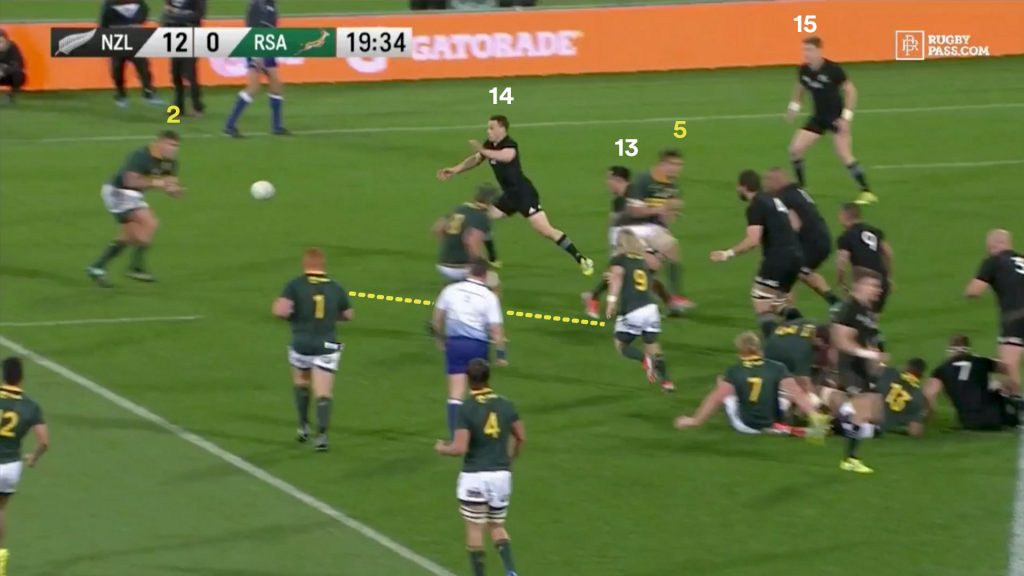
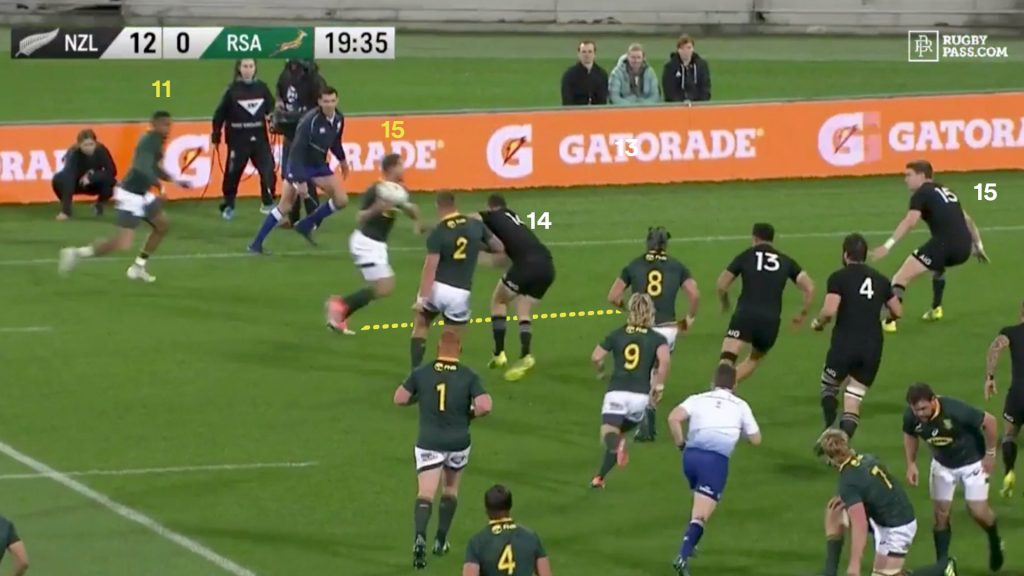
Barrett’s passive-jockey defence gives le Roux time and space to attack the two-on-one situation. Against the Springboks’ best playmaker, Barrett is left with low odds of preventing the try being scored.
The Springboks have exactly the situation they want, and execute accordingly. Le Roux baits Barrett into turning in at the last second, leaving Aphiwe Dyantyi (11) free to score untouched.
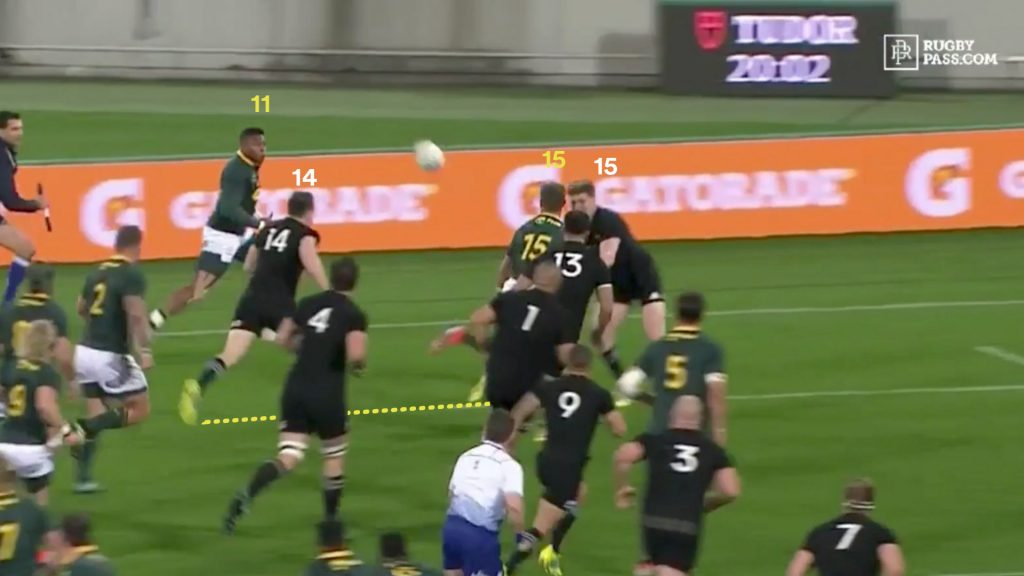
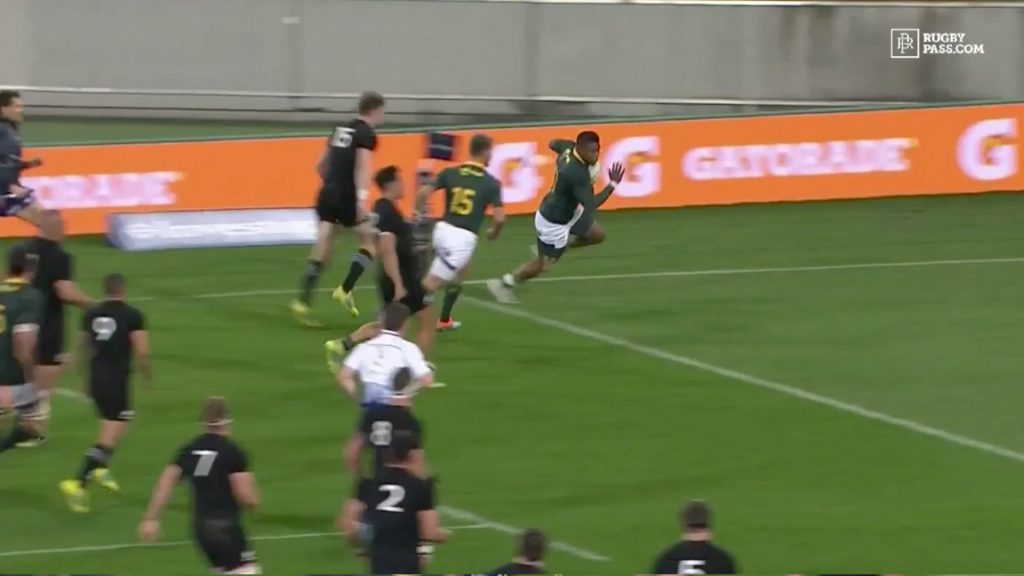
During this sequence, we saw four carries off the 9 and on the fifth phase the Springboks finally released their playmaker.
The flyhalf was not involved at all, and the midfielders were ‘expendable’ pieces used during the middle phases to provide a carrying option themselves or clean out at the ruck.
This is the type of launch commonly used by the Springboks. Powered by heavy use of their big men, the defensive line is battered by their natural abrasive style of collision-based rugby, before South Africa use their most effective playmaker in Le Roux for the finishing touch.
In the follow up test a year later in 2019, the Springboks run a variation of the same type of launch pattern but the timing is off and they fail to create as many phases going the same way.
After fewer lead-up phases, Lukhanyo Am (13) tries to provide a crossing line as Faf de Klerk feeds le Roux on the final ‘release’ phase. They end up with no space, forcing the Springboks fullback to put in a chip kick that hands over cheap possession.
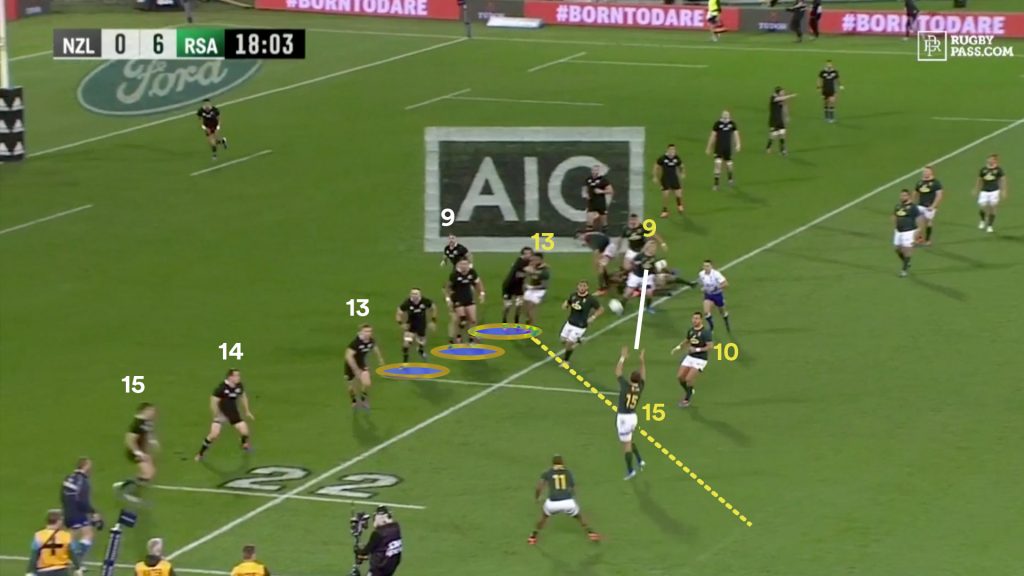
The All Blacks have much better numbers folding around the corner and unlike Jordie Barrett the year before, Beauden Barrett (15) reacted quickly to join from the backfield to create a black wall up front.
There is nowhere for le Roux to go but to try an unscripted kick with no chase.
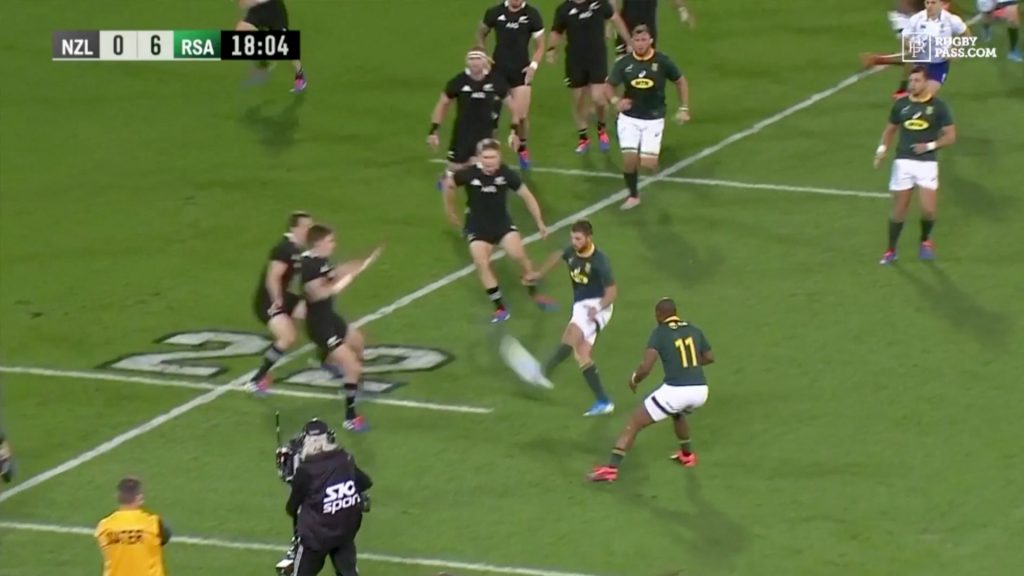
When the Bok pattern is successful at creating thin edges for le Roux, the crossing lines by the centres are timed effectively and the forwards are getting around the corner quickly.
These crossing lines run by the Springboks midfielders are a key feature of these multi-phase sequences that you will see occur frequently and their impact is two-fold.
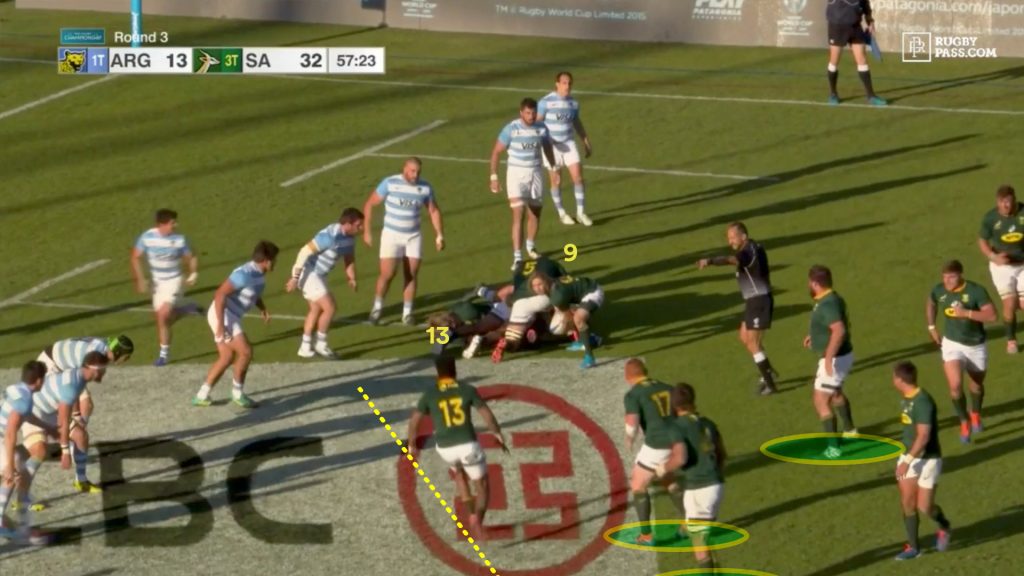
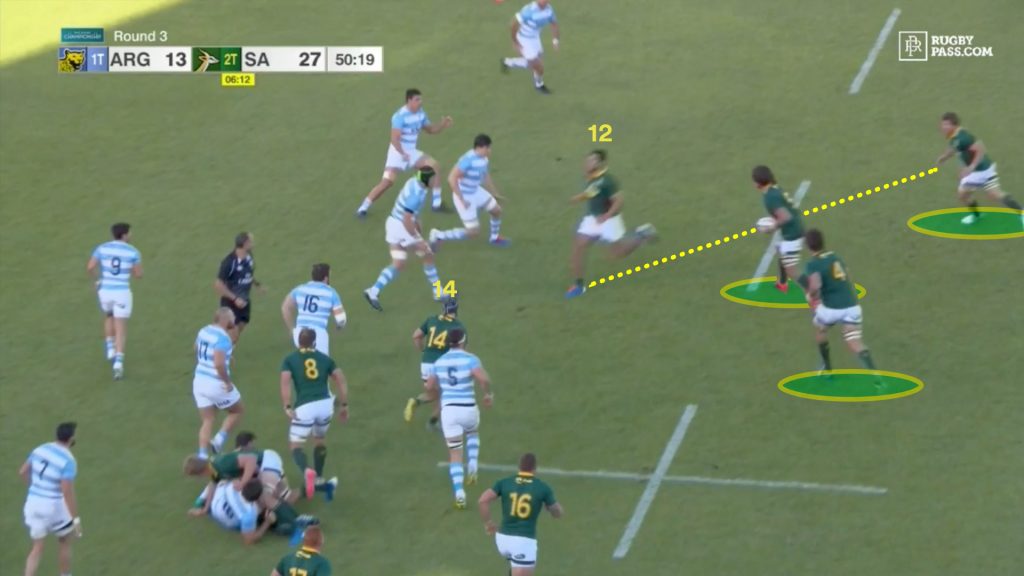
If the halfback hits the midfielder option running flat, the next ruck is close by due to the hard angle run back towards traffic, preserving the width and allowing for more phases to occur going the same way to keep wearing down the defence.
If the forward carry is used, the midfielder will hopefully get away with a ‘chip block’ or draw some interest in front of the carrier, giving the ball carrier a higher chance of making a gain line carry.
The midfielder can delay the inside defender from helping, preventing two-man hits at the point of contact. This creates a one-on-one contact situation which the Springboks are built to win.
The likes of Pieter-Steph du Toit, Duane Vermuelen, Eben Etzebeth and Siya Kolisi have the extra time to power through the one-on-one tackle with their leg drive before the second man arrives.
Against Wales, Handre Pollard (10) has moved to inside centre to accomodate the injection of Elton Jantjies (22) and performs the crossing line across the face of Bongi Mbonambi (16) on the second phase of another Bok pattern launch.
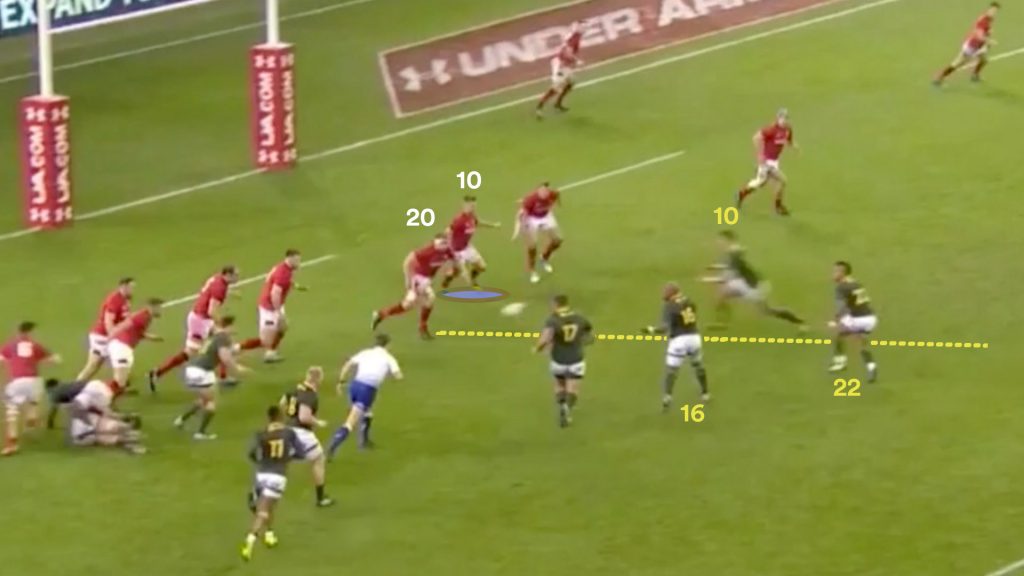
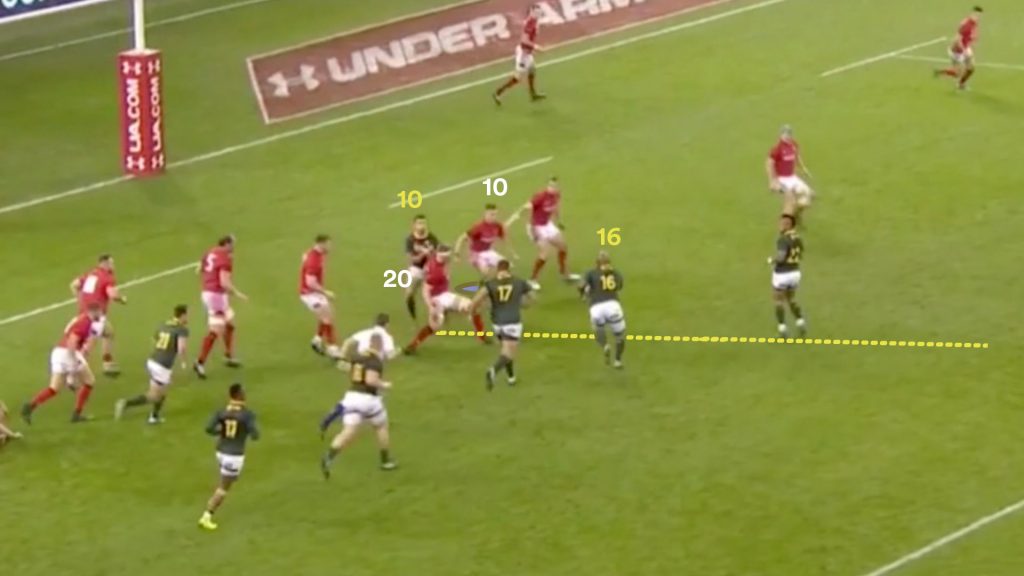
The crossing line delays flanker Aaron Wainwright (20) with a chip block, giving Mbonambi the opportunity to drive at Anscombe’s inside shoulder with no inside help.
Pollard’s half-block on Wainwright creates separation between the flanker and the Welsh flyhalf, forcing Anscombe to take down Mbonambi by himself. The Springbok prop is able to earn some extra metres from the carry as a result of the size mismatch, building the gain line momentum the Springboks want before the release phase.
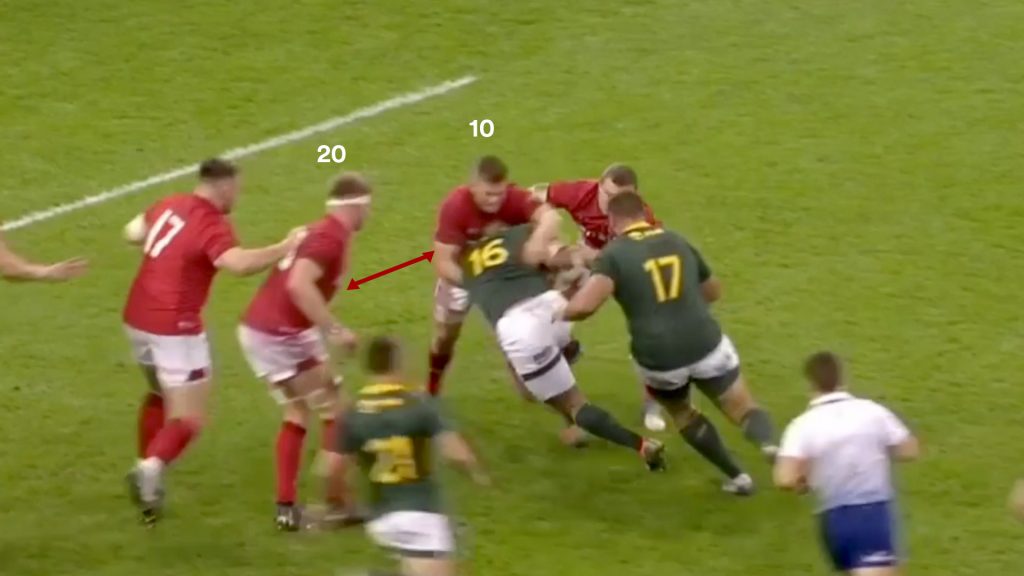
We see all the elements of the Springboks favourite pattern working again in Pretoria against the All Blacks in 2018, this time with Pollard, back in his usual position at 10, involved as a link man on the release phase.
From the scrum, Faf de Klerk works an inside pass to Francois Louw, a nice play designed to prey on the overeagerness of All Black openside Ardie Savea (20), and the slower release by Kieran Read (8).
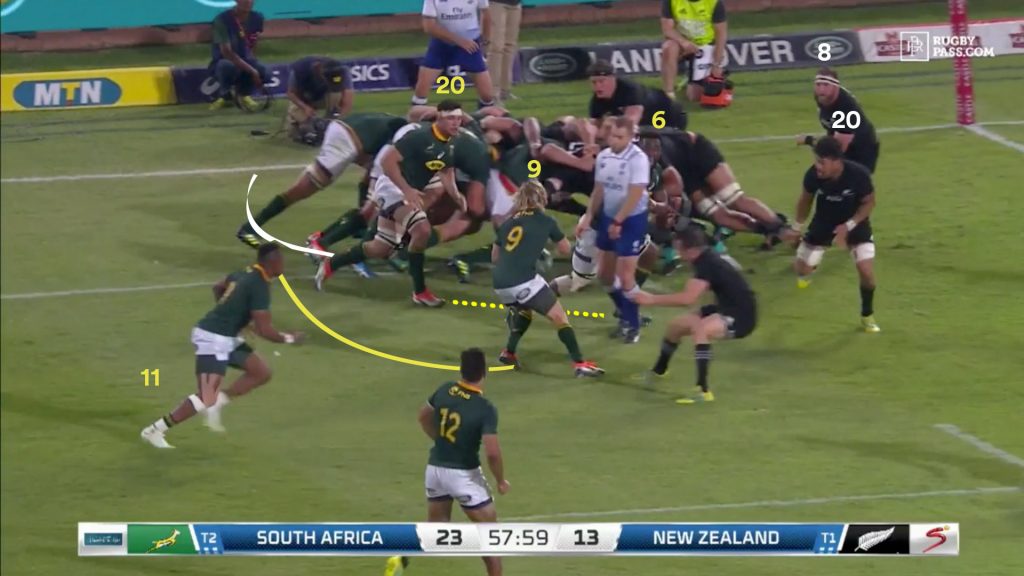
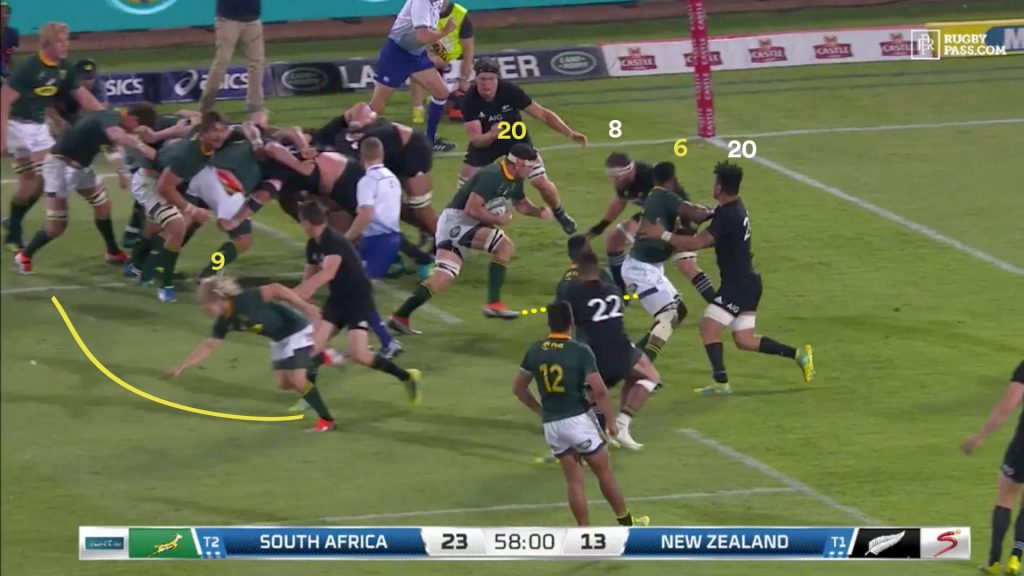
The successful first phase play puts the All Blacks on their own goal line while tying up the entire All Blacks loose forward trio around the ruck to prevent any quick pick-and-goes. The Springboks still have large swathes of the open side space to run a long, multi-phase sequence to thin down the far edge.
On the second phase, they use one of their strongest ball carriers, Eben Etzebeth, with a pre-orchestrated latcher in Pieter-Steph du Toit to test Richie Mo’unga seen crouching on the goal line.
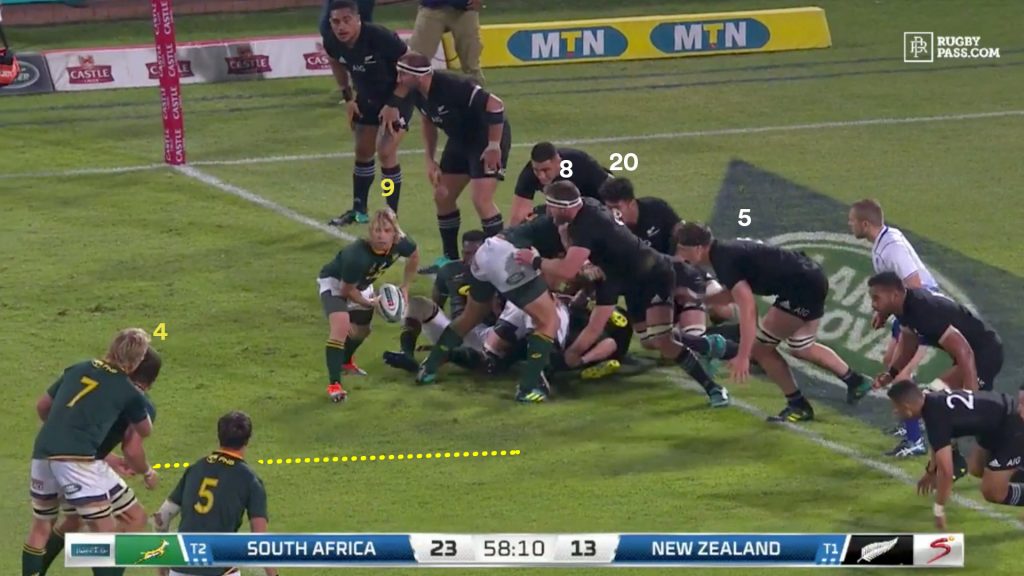
On the third phase, Faf de Klerk hits his midfielder, Damian de Allende, running a crossing line across the forward carrying option Steven Kitshoff (1). De Allende clatters into Scott Barrett (out of picture outside Read), taking him to the ground.
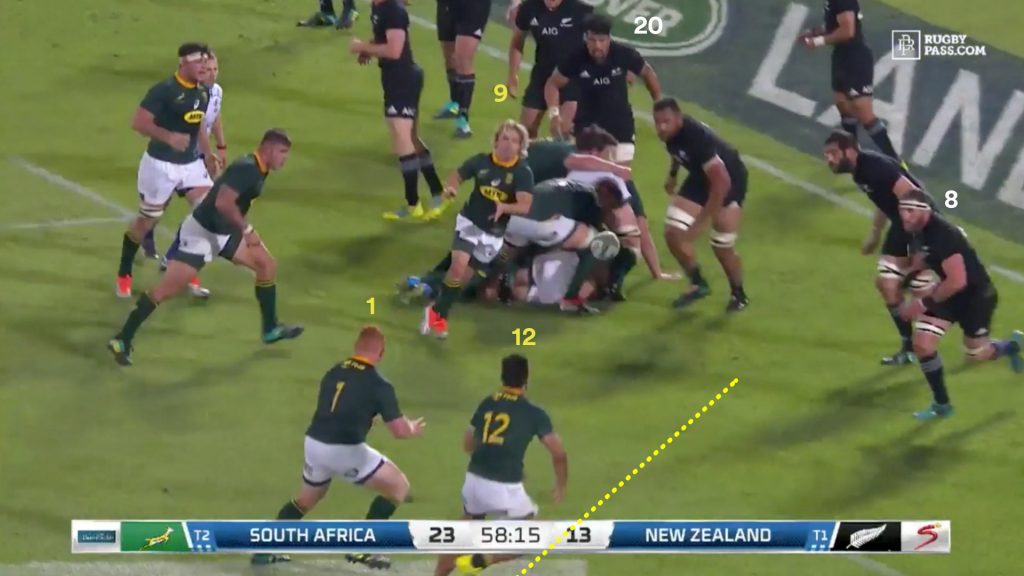
The first three phases of the launch have successfully tied up Ardie Savea and Scott Barrett. Read (8) is the last standing loose forward on the open side, and by the fourth phase, the All Blacks defence is incredibly crowded around the ruck, with six players all seen standing nearby.
The time is right for the Springboks to run the ‘release’ play, using Jesse Kriel (13) on another crossing line for the second time in this sequence.
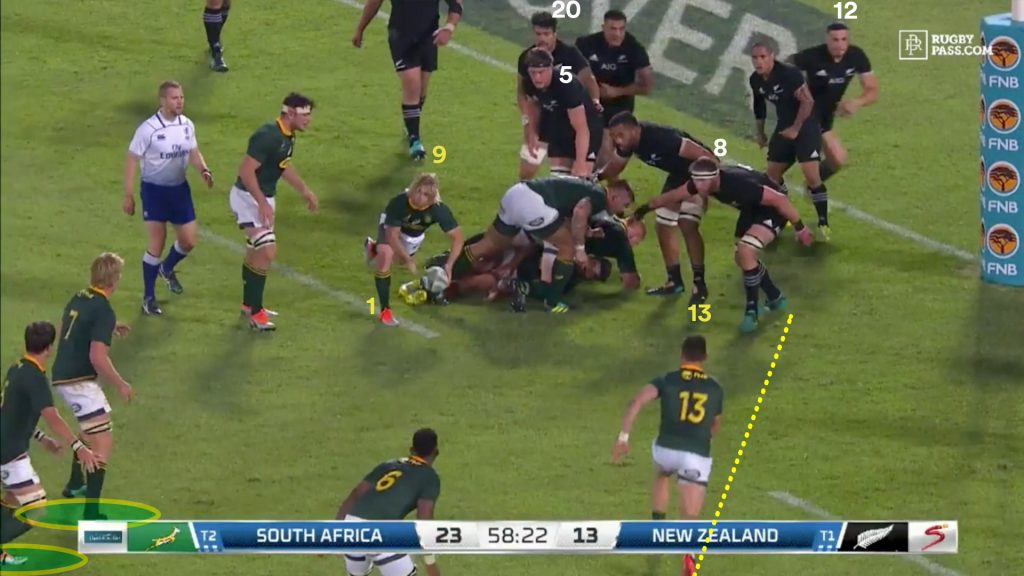

The Springboks need to get Willie le Roux the ball as early as possible as the All Blacks’ edge has already been thinned out. This is where the flyhalf is injected into the sequence to become the link man to get swift ball to the fullback.
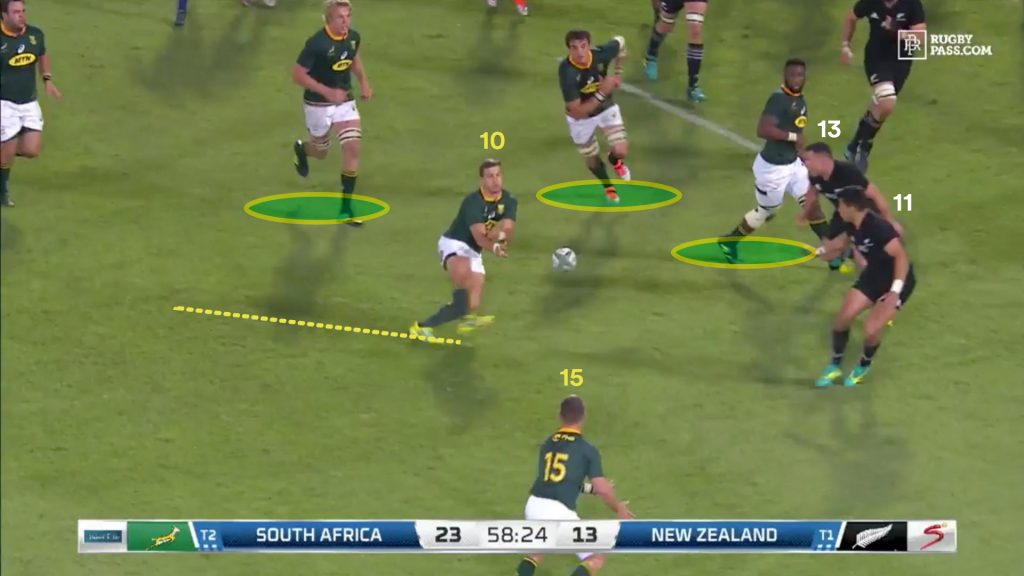
Pollard’s touch is a quick one, getting a backdoor pass from Mostert and firing wide to le Roux. As Rieko Ioane (11) has already drifted in-field, there is only the All Blacks fullback left to draw and le Roux has his winger Cheslin Kolbe outside.
The final two All Black defenders in the front line, Ryan Crotty (13) and Rieko Ioane (11), know they are outmanned but can’t push up enough to shut down the play in time. The Springboks depth at the second level behind the pod is perfect to draw them forward but keep them at arm’s length, leaving them helpless for the wide play.
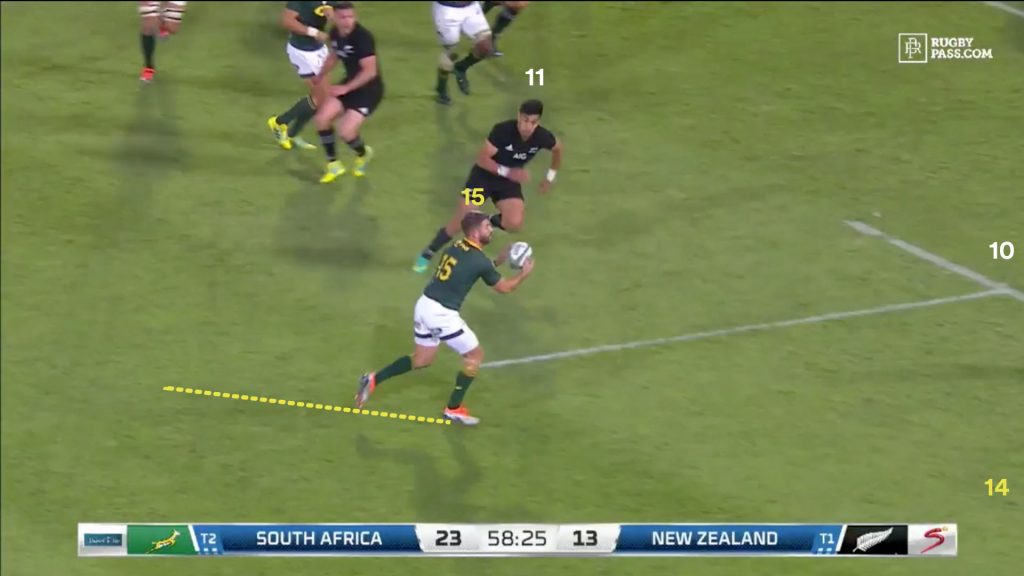
Le Roux has exactly what he wants again, a two-on-one with the opposite fullback. He is so rehearsed at picking the exact time to pick the final pass, only a colossal error would prevent the Springboks from scoring.
This final pass isn’t le Roux’s best, but Kolbe doesn’t need much space to finish from five metres out. Despite an early pass from le Roux, Kolbe is able to step inside Beauden Barrett and ground the ball over the line.
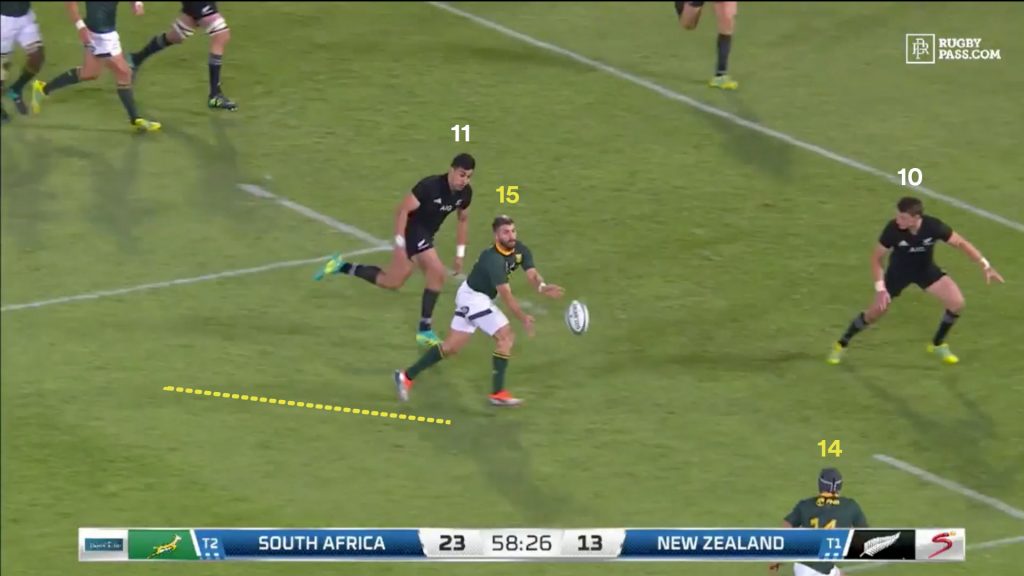
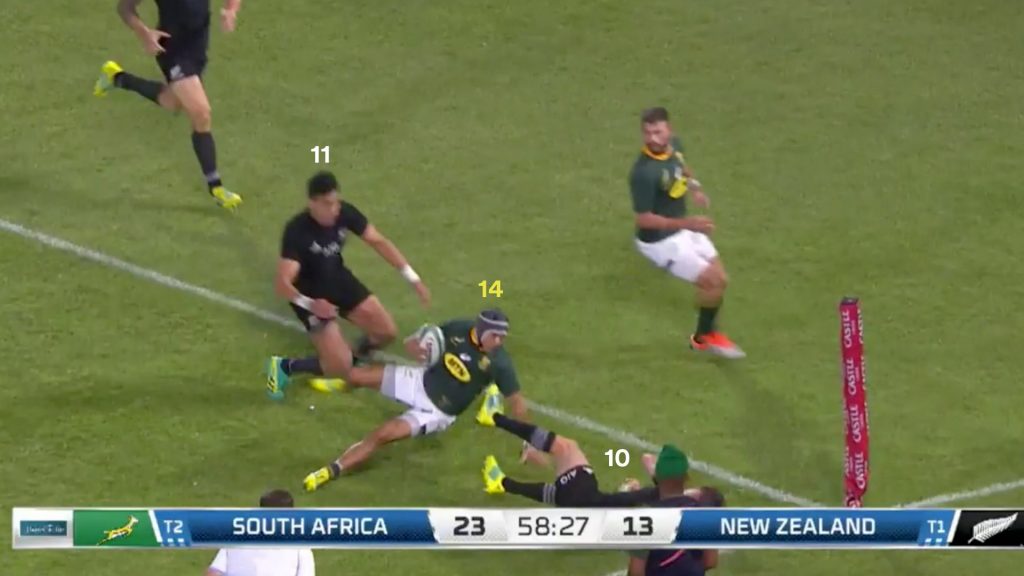
Again we see all the elements of a successful Springboks attacking raid: narrow ruck spacing as four phases are executed the same direction, multiple uses of forward carries, crossing lines from both midfielders, removing them from any involvement on the ‘release’ phase, and early ball on the last phase to the playmaker le Roux to capitalise on the two-on-one opportunity.
Any time the Springboks manufacture a two-on-one for their star fullback, it is often too late for the defence. The slow developing ‘Bok pattern’ isn’t the only way to do this, they can throw in quick strikes as a variation.
At home against England in 2018, a quick release on a double midfield clear out from a scrum gives Le Roux possession on the outside of England winger Mike Brown (11).
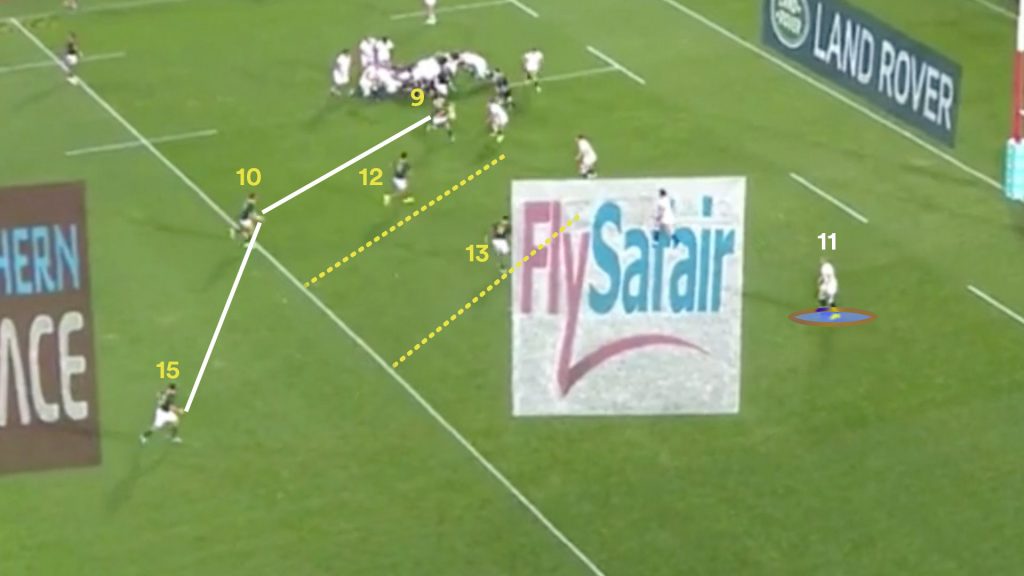
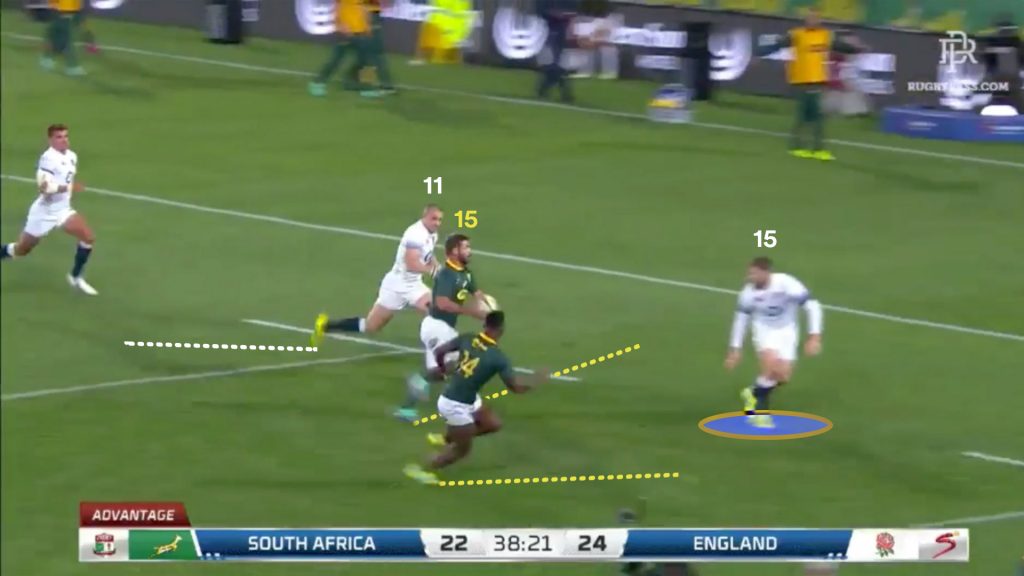
The simple two-pass play gives the fullback early ball and plenty of space. Le Roux outplays his former teammate Elliot Daly by shaping to pass before taking the gap and crashing over.

It is clear that le Roux has been the key cog in the production of any of the Springbok tries since Erasmus took over.
Although much of the examples are from 2018, this is a period where the Springboks played a more expansive game. With only three Rugby Championship tests played before the World Cup and only one test at home in 2019, there were limited ‘non-tournament’ games to review where circumstances may mirror the upcoming Lions series.
As South Africa went deeper into the World Cup, red zone patterns were rarely seen as penalty shots at goal became the preference and set-piece platforms were also used to draw penalties, from scrum dominance and lineout maulling, rather than playing for tries.
Each test in the Lions tour will present a different dynamic that will be unlike the World Cup knockout games, in which both sides have equal pressure and stakes on the line. The first test won’t decide the series, giving both a certain amount of freedom to attack.
In the second test, the two sides will have different motivations: one will be playing for their lives and the other with a desperation to seal the series. The two emotional states are very different and can bring forth differing responses; a team playing for their lives might play conservatively or with a ‘cavalier’ nothing-to-lose approach. The team with the series lead needs to match that desperation to seal the series, which can be difficult to achieve knowing a loss won’t end their series ambitions.
Only a deciding third test will provide a similar feeling to a World Cup knockout game, with everything on the line.
It is reasonable to expect that we will see a different Springboks side throughout the series, one that opens up the playbook and plays more like the Springboks we see at home, where raucous crowds and afternoon rugby bring out the best in them.
And that will provide a prominent role for Willie le Roux to play as the lynchpin of their attacking plans.


Comments
Join free and tell us what you really think!
Sign up for free